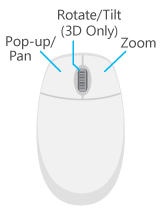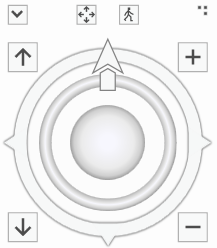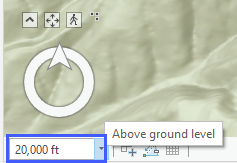Navigation
When you work with 3D and 2D viewers, you can zoom in and out, move around, and in the case of globes, move up, down, and look around. The main navigation tools are the Explore tool ![]() , the on-screen Navigator
, the on-screen Navigator ![]() , and the Go To XY tool
, and the Go To XY tool ![]() .
.
Other ways to navigate include the following:
Navigation in 3D—Explore in x,y and z, rotate and tilt, access modes for planar navigation and first person navigation.
Keyboard shortcuts—Use keyboard keys in conjunction with the Explore tool to reposition the view or to perform navigation actions when another tool is active.
Pause and refresh drawing—Improve interactive performance when navigating globes.
Learning how to navigate effectively can improve the way you interact with globes and viewers. You may need to use a combination of these options when navigating. Navigation commands are available on the Globe tab in the Navigate group. Some commands also exist in context menus when you right-click an entry in the project tree.
Explore viewers and globes
The default tool viewers and globes is the Explore tool ![]() , which is used to move, pan, and zoom in and out of viewers and globes.
, which is used to move, pan, and zoom in and out of viewers and globes.

When you pan through a viewers or globe with the mouse, the pointer becomes a hand. Right-click and hold the mouse button, and move the mouse up or down to zoom. The pointer becomes a magnifying glass when you click the right mouse button.
All Explore tool capabilities are described in the table below alongside other common navigation commands.
In a situation where your mouse does not have the middle button or wheel, or you are navigating using a touch screen or track pad, keyboard shortcuts, and the navigator control will help to provide access to these navigation commands, such as tilt (3D) or rotate (2D/3D).
|
Navigation command |
Description |
|---|---|
|
Explore |
A multifunctional tool for navigation and feature identification. This is the default tool when you open a new or existing project. Left, right, and wheel mouse buttons all have built-in capabilities as follows:
|
|
Full Extent |
The view zooms to the full extent of the data in the globe. |
|
Zoom To Selection |
The view centers and zooms in on the extent of the selected set of features. Zooming to a single selected feature zooms to its full geometry; however, when zooming to a single selected point, the view zooms in a fixed percentage. |
|
Fixed Zoom In |
Zoom in or out at a fixed distance. |
|
Previous Extent |
Every change in the extent of the globe is stored so you can go backward and forward through in a list of globe extents. Move the view back to the previous extent or forward to the next extent, if it exists. When the Explore tool is active, you can also right-click to navigate to the previous or next extent. This list of extents is only maintained as long as a view is open. The positions are cleared after the application is closed, even when a view is saved as open in a project. |
|
Go To XY |
Display an on-screen control to view or edit the camera coordinates, direction and field-of-view angle. You can change the location's units format, which matches the coordinate system used in the globe, as needed. |
Note:
If you change the active tool to something other than the Explore tool, the other mouse buttons may update. For example, if the active tool is the Select tool, often the middle button becomes the pan tool and the right button is the continuous zoom tool. Keep in mind that another active tool may have mouse buttons configured differently for the purpose of that tool, which may not even be related to navigation.
On-screen navigator
The on-screen navigator provides camera navigation commands in a single control in the lower left corner of a globe. The navigator always indicates north and the cardinal points on the navigator are clickable to help you reorient. The control is suitable for touch screen interaction.


In the minimized display mode, the navigator shows a north indicator only. In globes, there are additional buttons to switch navigation modes between planar navigation and first-person navigation. You can pan your globe by clicking and dragging the outer ring. A partially transparent arrow indicates the pan direction and velocity. Click the north arrow to reset the camera to face north again.
In globes, you can rotate the view direction, pivot around the target point in all three axes, zoom in and out on the target point, move the camera up and down, and look around from the current camera position.
To change default settings, click the Project tab and click the Options tab. On the Options dialog box, click the Navigation tab. Expand the On Screen Navigator heading to configure these options.
Pause and refresh drawing
There are two buttons at the lower right of the globe to help with interactive performance, Pause Drawing and Refresh. When a globe contains a large amount of data, it takes time to load the content into memory and draw it. When a globe is actively drawing data, the Refresh button ![]() spins. Click Refresh to cancel the drawing. Any features that are already drawn remain, but no additional features are added to the display.
spins. Click Refresh to cancel the drawing. Any features that are already drawn remain, but no additional features are added to the display.
Alternatively, use the Pause Drawing button ![]() to temporarily stop the drawing of globes. When this button is clicked, the word Paused appears across the top of the view and no additional data loads until it is switched off. All navigation and editing functionality is available during this time so you can make changes to the globe's content without causing a redraw of the globe. If you turn off the visibility of a layer or add a new layer to the globe, the new content does not display until you exit the paused drawing state.
to temporarily stop the drawing of globes. When this button is clicked, the word Paused appears across the top of the view and no additional data loads until it is switched off. All navigation and editing functionality is available during this time so you can make changes to the globe's content without causing a redraw of the globe. If you turn off the visibility of a layer or add a new layer to the globe, the new content does not display until you exit the paused drawing state.
Change globe scale or height above ground
In the globe, you set the height above ground. When a globe draws, you can display it at any scale. You can set a series of scales so you can select them directly from a list.
To change scales, the scale control is located at the lower left corner of the display. You can type a value, or click the scales list and choose a value to zoom to the specified scale. To customize and manage the list of scales, click Customize to open the Scale Properties dialog box.
Height values in 3D are listed at the bottom of the globe's display and depict height above ground. For example, if you enter a value of 2 meters as a 3D height, the viewpoint adjusts to 2 meters above ground whether you're in a mountain range or by the ocean. The value displayed in the 3D height box is based on the current resolution of the elevation being displayed. It becomes progressively more accurate the closer you get to the ground.

The 3D height control value is different than the distance-to-pointer z-value depicted in the coordinate system display, which is also at the bottom of the view. Z-values represent the elevation of the current pointer location in the view. For example, to view mountains from 100 feet above ground in your study area, type 100 in the height list. This moves the view to 100 feet above ground. To find the elevation of one mountain in particular, position the pointer at the top of the peak. Observe the z-value that appears at the bottom of the display, grouped with the coordinates to see the mountain's elevation.